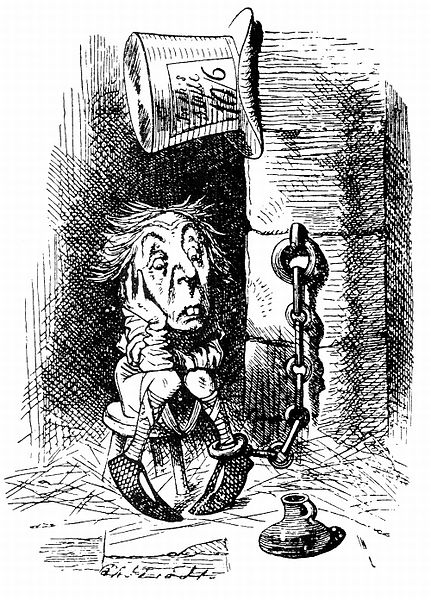Mad Hatters
Nonfiction Reading Test

The Mad Hatter as drawn by John Tenniel in 1865
A hatter is a person who makes hats. Hatters are also known as milliners. People have been wearing hats for a long time. So, millinery is an old profession. We can trace the use of the word back to the 1600s.
Perhaps the most famous real-life milliner is Coco Chanel. She founded the Chanel brand after World War I. Her brand is still popular today. But the most famous milliner of all may be the Hatter from Alice's Adventures in Wonderland.
The Hatter first appears in Lewis Carroll's 1865 novel in “Chapter Seven – A Mad Tea-Party". The Hatter claims to Alice that it is always six o'clock and so it is always tea-time. He speaks in riddles to which he does not know the answer. And he changes his seat at the table at random. This character is known as "the Mad Hatter," and even the Cheshire Cat calls him mad.
In Carroll's time, many hatters suffered from mental illness. In fact, the phrase "as mad as a hatter" was in print in 1829. This was several decades before Carroll's character appeared. It is now understood that this madness was due to mercury exposure.
Mercury was once a secret ingredient in hatting. Hatters would steam and press animal fur. Then they would add a compound made from mercury to stabilize the fur. They called this process felting. It made for some nice hats. It also gave hatters mercury poisoning.
Erethism, also known as "mad hatter disease," is a mental disorder. It is due to having too much contact with mercury. Those who suffer from it shake beyond their control. Their personalities may change. They may lose their memories. Or they may hallucinate. It is a damaging condition.

Maddening, isn't it?
Speaking of madness, the small city of Danbury, Connecticut, was once known as "Hat City." During the 1800s and 1900s, as many as 75% of American-made hats came from Danbury. And a lot of workers from this city got mercury poisoning. There were so many cases that the condition was known as the "Danbury shakes." The madness of it all is that people knew the cause.
Although the hazards of mercury had long been known, it wasn't studied until the 1860s. Yet by 1869 science proved the health hazards that mercury posed to hat makers. And in 1874 and 1888 people created new, safer methods of felting using acid. But the American hat industry continued to use mercury for another 60 years. Isn't that maddening?
The use of mercury in hatting finally ended during World War II. It wasn't because people discovered that it was hazardous to workers. (They already knew that.) It was because mercury was needed to create detonators for the war effort. Connecticut banned the use of mercury in hat-making in 1941. To this day the banks of the Still River in Danbury still test high for levels of mercury waste.